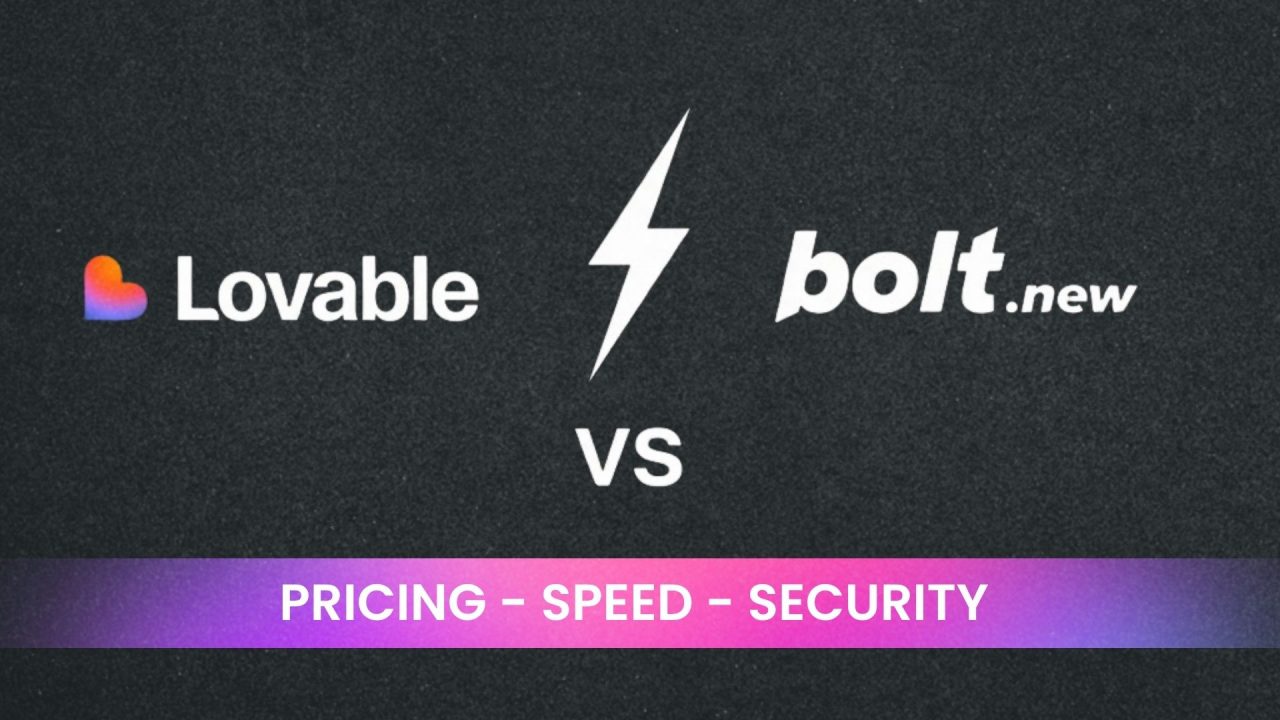No-code software development is one of the prominent revolutions that dominate the fast-paced world of modern app creation. It has transformed the way ideas come to reality in the form of products. There is no need nowadays to be a genius coder to create smooth, high-powered, and scalable applications. At the core of this change are two major platforms — Lovable and Bolt.
They both promise to make teams more empowered, faster, and innovation painless. However, which one really stands out when it comes to deciding between the two?
Launch Your App Today
Ready to launch? Skip the tech stress. Describe, Build, Launch in three simple steps.
BuildUnderstanding the No-Code Revolution
Before we immerse into comparisons, it would be important to take a breath knowing why no-code solutions such as Lovable and Bolt are sweeping the software scene. The conventional ways of app development used to take months, even years, of work, several developers, and big budgets. But no-code tools reversed the script.
They brought in drag-and-drop interfaces, graphical logic, and on-the-fly deployment — without a single line of code. Businesses loved it. Entrepreneurs embraced it. And today, even businesses are using no-code platforms to come up with rapid prototypes, lower the cost of development, and empower non-tech teams.
Both Lovable and Bolt serve this increased demand, though in their own way.
Here are the Contenders: Lovable and Bolt
Lovable — Where Design Meets Simplicity
Lovable has been creating quite a buzz among startups and creative teams. It’s a no-code development platform focused on building user-centric applications with a touch of simplicity and visual finesse. Lovable is all about intuitive design, rapid prototyping, and team collaboration.
What makes Lovable stand out is its clean interface, designed to make the creation process feel smooth and—well, lovable. It’s perfect for startups that want to transform ideas into prototypes quickly, test them, and iterate without feeling bogged down by technical barriers.
Bolt — Power Meets Speed
Bolt, on the other hand, takes a more performance-driven approach. Known for its speed and efficiency, Bolt empowers teams to build robust applications that are ready to scale. It’s not just about looks — it’s about functionality, integration, and power.
Bolt’s ecosystem supports complex workflows, automation, and AI-powered features. It’s built for teams that want to move fast without compromising on technical depth. If Lovable is the artist, Bolt is the engineer — precise, fast, and optimized for performance.
Ease of Use: Who’s the Winner?
When comparing Lovable and Bolt, usability takes center stage. After all, the whole point of no-code is to make development accessible to everyone.
Lovable’s interface feels like working with a design tool rather than a development platform. You can drag, drop, and deploy in minutes. The layout is modern, minimal, and beginner-friendly. It guides users intuitively through every step — from wireframes to functional apps.
Bolt, while user-friendly, leans slightly toward the power-user crowd. It offers deeper functionality and more customization options. Beginners might need a short learning curve to understand its advanced settings. But once you get the hang of it, the possibilities feel limitless.
In short — Lovable wins on simplicity, while Bolt wins on flexibility.
Speed and Performance: Who’s Faster?
In a digital race, speed can make or break your workflow. Bolt’s architecture is built for blazing-fast app creation and deployment. Its backend optimization and cloud-native setup ensure that your applications load quickly and handle multiple operations seamlessly.
Lovable isn’t slow either, but its focus lies more on the user experience than on raw speed. It’s ideal for prototypes, MVPs, and lightweight applications that need to look polished rather than handle massive datasets.
When performance under pressure matters, Bolt clearly edges out Lovable.
Collaboration and Teamwork
No-code tools shine brightest when they help teams collaborate efficiently.
Lovable excels in collaborative design and prototyping. It allows multiple team members — from designers to marketers — to work on a single project in real-time. Comments, version history, and live editing make teamwork feel natural and dynamic.
Bolt, meanwhile, integrates tightly with project management tools like Jira, Trello, and Notion. It encourages cross-functional collaboration between developers, designers, and business analysts. It even supports role-based access control, which adds an extra layer of professionalism to enterprise environments.
So, if your team is creative and design-led, Lovable fits the bill. But if you’re managing larger, cross-functional projects, Bolt is the powerhouse you need.
Integration Capabilities
Modern businesses run on integrations — connecting apps, tools, and data pipelines is non-negotiable.
Bolt shines here. It supports hundreds of integrations with popular tools — from CRMs and analytics platforms to automation systems and APIs. Whether it’s connecting Salesforce, Slack, or custom databases, Bolt makes integration feel effortless.
Lovable’s integration library is growing but not as expansive. It’s more suited for small businesses or startups that rely on popular, mainstream tools like Google Workspace, Airtable, or Figma.
For complex tech stacks, Bolt’s integration strength is unmatched.
Customization: How Much Can You Tweak?
Customization defines how much control a user has over their final product.
Lovable focuses on visual customization — colors, typography, layouts, animations, and user interface components. It’s perfect for teams that want to make their applications look stunning without diving into technical complexity.
Bolt, conversely, takes customization a step further. It allows users to tweak workflows, logic layers, and data models. Advanced users can even inject custom code snippets if needed, bridging the gap between no-code and traditional development.
Simply put, Lovable is for design perfectionists, and Bolt is for performance-driven innovators.
Learning Curve and Support
When you’re new to no-code, support and learning materials matter a lot.
Lovable’s onboarding experience is smooth and friendly. It uses guided tutorials, templates, and community-driven support to help users start fast. Beginners will appreciate the hand-holding approach that feels less intimidating.
Bolt provides a more structured learning path with documentation, webinars, and advanced community support. It’s geared toward professionals who want to dive deeper into complex use cases and enterprise workflows.
In essence — Lovable teaches you gently, while Bolt trains you like a pro.
Pricing and Value
Pricing often becomes the deciding factor, especially for startups and SMBs.
Lovable typically offers affordable plans suitable for small teams and individual creators. Its free tier gives enough functionality to experiment and build basic applications. Paid plans unlock more templates, integrations, and collaboration features.
Bolt’s pricing is positioned higher — and rightly so, considering its enterprise-grade capabilities. It’s designed for organizations that need scalability, data security, and advanced customization.
For early-stage entrepreneurs, Lovable offers great value. For fast-growing businesses or enterprises, Bolt justifies its cost with powerful infrastructure.
Security and Scalability
In the world of app development, security can’t be an afterthought.
Bolt boasts enterprise-level security — with features like encrypted data transmission, multi-factor authentication, and access control. Its cloud-native infrastructure is built to scale effortlessly, supporting thousands of concurrent users.
Lovable also prioritizes security but focuses more on small-to-medium projects. It’s reliable and secure but not optimized for massive enterprise-level scaling.
If you’re planning to grow your app into a high-traffic product, Bolt’s infrastructure gives you peace of mind.
Innovation and Updates
The no-code space evolves fast. Regular updates and new features are crucial to stay ahead.
Lovable’s updates are creative and user-experience focused — introducing new templates, design libraries, and UI enhancements. It listens closely to its community, constantly improving ease of use.
Bolt’s updates lean towards technical innovation — AI-powered logic builders, workflow automation, and integration expansion. It’s shaping itself into an intelligent no-code engine for serious professionals.
Both platforms innovate actively, but in different directions. Lovable innovates for creators, while Bolt innovates for builders.
Verdict: Which One Should You Opt For?
Then, having gone through all this comparison, who is the winner in the Lovable vs. Bolt showdown? Well, there is no universal answer to that question, and it depends on you and your needs.
Lovable is the right place to be in case you are a startup founder, designer, or small team that cares about aesthetics, collaboration, and simplicity. It is playful, easy to use, and best suited to produce breathtaking prototypes or lightweight applications in a hurry.
Bolt is your smarter investment, particularly if you are a tech-driven business, enterprise, or power user, and seeking scalability, deep integration, and performance. It is quick, flexible, and suitable to serious production setups.
In brief — Lovable wins hearts, Bolt wins the race. But what if the race itself is changing?
The Next Evolution: AI-Driven No-Code Platforms
The comparison between Lovable (simplicity) and Bolt (power) is central to the current no-code market. However, a new category is emerging that changes the fundamental starting point of creation. These AI-driven platforms aim to democratize development even further by eliminating the “blank canvas” problem.
Instead of starting with a drag-and-drop interface, these tools start with a natural language prompt. A founder or entrepreneur simply describes their app idea in plain English. The AI then interprets this idea and generates the foundational architecture, database schema, and initial UI.
A prime example of this new wave is Imagine.bo. This platform is designed specifically for founders and entrepreneurs who need to launch a Minimum Viable Product (MVP) at maximum speed.
Here is a quick comparison of the paradigms:
| Approach | AI-Driven No-Code (e.g., Imagine.bo) |
| Starting Point | Text prompt; user describes their app idea. |
| Core Mechanic | AI generates the foundational app and logic. |
| Initial Build Time | Near-Instant (Minutes/Hours) |
| Primary Goal | Validate an idea and launch an MVP. |
| Advanced Hand-off | Seamless Hand-off to a developer when stuck, with clean, exportable code. |
| Security/Compliance | Guaranteed Better Security and compliance built-in via AI code review and secure deployment pipeline. |
| Scalability Guarantee | 1000 transactions/second guarantee built-in for high-performance and scalability. |
Platforms in this new category, like Imagine.bo, focus on solving key founder pain points:
- Speed-to-Market: The primary value is reducing development time from months to days, allowing for rapid idea validation.
- Full-Stack Generation: The AI doesn’t just build a frontend. It aims to create a scalable backend, set up databases, and ensure security (like GDPR/SOC2-readiness) from the start.
- Hybrid Support: Recognizing that AI generation isn’t perfect, these platforms often blend AI building with access to real-time human engineer support for bug fixes or advanced customization.
- Founder-Focused Tools: They often come with built-in analytics, one-click deployment, and mobile responsiveness, as the target user is a business builder, not just a designer or developer.
This AI-driven approach doesn’t replace visual builders like Lovable and Bolt, but rather serves a different, crucial need: getting a professional-grade, scalable MVP into the market with the lowest possible friction and technical stress.
The Final Takeaway
It is not a contest between Lovable and Bolt on who is better in general but what is better to you. Both of them are rewriting the no-code territory in their own manner.
Lovable simplifies the process of creating apps and transforms the sophisticated design concepts into interactive products within the shortest amount of time possible. Bolt makes dreams a reality by enabling teams to create and deploy at blazing speed.
Regardless of your choice of side, one thing is definite — no-code is the future of software development. As you evaluate your options, your choice is no longer just between simplicity (Lovable) and power (Bolt). You must now also consider the third-generation, AI-driven platforms (like Imagine.bo) that focus on pure speed-to-market.
And Lovable and Bolt are taking the lead in that future. Because speed and creativity are inseparable, and innovation cannot be stopped.
Launch Your App Today
Ready to launch? Skip the tech stress. Describe, Build, Launch in three simple steps.
Build




